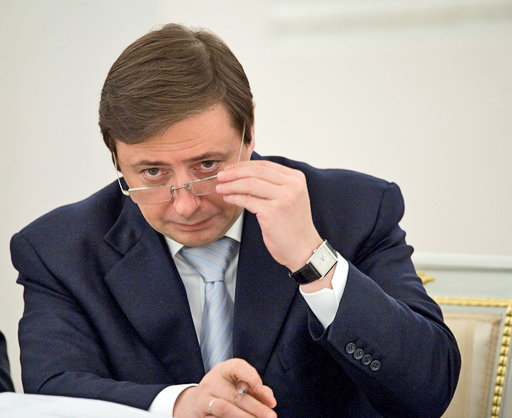
Anti-Caucasian Russian Separatism on the Rise in Stavropol Region
Publication: Eurasia Daily Monitor Volume: 9 Issue: 168
By:

On September 6, the Russian president’s plenipotentiary representative in the North Caucasus, Alexander Khloponin, intervened in a protracted conflict between the Dagestani and Stavropol authorities. The Stavropol region’s eastern districts have been increasingly populated as a result of inward migration from the neighboring republic of Dagestan. Stavropol is a predominantly ethnic Russian region and Dagestan is predominantly non-Russian. Authorities in Stavropol have habitually tried to put obstacles in the way of Dagestani migrants to prevent their migration into sparsely populated areas in the east. Imposing artificial limitations on registration in the Stavropol region has been one of the main ways to block the migration of Dagestanis, despite the fact that they are citizens of Russia along with the residents of Stavropol. During the Soviet period, 150,000 acres of land in Stavropol were given to Dagestani agricultural entities for “eternal” use as pasture and ploughed land. After the demise of the USSR, the Stavropol region reclaimed rights over that land and the dispute has not yet ended (https://kavpolit.com/kuda-uxodyat-chabany/).
According to the 2010 census, Stavropol region has a population of 2.8 million, and Dagestan has a population of 2.9 million. They are also comparable in terms of size: Stavropol’s total area is 66,000 square kilometers while Dagestan’s is 50,000 square kilometers. The differences are illustrated by the dynamics of the regions. The regional population of Stavropol grew by two percent in the period between the Russian censuses of 2002 and 2010, while Dagestan’s population grew by nearly 16 percent during the same period. Another important difference is that Dagestan has a significantly larger percentage of people living in the rural areas than the Stavropol region—55 percent versus 43 percent (www.gks.ru, Russian State Statistical Service). This means that, on average, people in Dagestan depend on subsistence from land more than do Stavropol region residents. Dagestan is also far more mountainous than the Stavropol region and thus has a much smaller amount of arable land.
In addition to economy-related issues, political shifts have also pitted Stavropol region against Dagestan. Soon after Stavropol became the only predominantly ethnic Russian region in the newly created North Caucasian Federal District in 2010, activists in Stavropol initiated a public campaign to secede from the non-Russian district. The campaign was quickly curbed by the Russian authorities, but the feeling of being the only “Russian republic” in the North Caucasus Federal District has not gone away, and hate crimes regularly occur there. For example, on July 21, a Cossack patrol in the city of Kislovodsk, which is a resort area in the south of Stavropol region, clashed with a group of Caucasians and killed two people (www.kavkaz-uzel.ru, July 23). On August 22, an unknown group—according to some reports it was made up of FSB officers; according to others, it was called the “White Bears”—attacked non–ethnic Russian traders at the local market in the city of Stavropol with guns (https://kommersant.ru/doc/2006807).
The conflict between the Stavropol region and Dagestan became especially acute in 2010. On November 30, 2010, Dagestan’s President Magomedsalam Magomedov wrote a special letter to then Russian President Dmitry Medvedev stating that Stavropol authorities excluded Dagestanis from all auctions for renting agricultural lands in the region. Only residents of Stavropol were given renting rights, and they in turn sublet the land to Dagestanis, simply because there are no other people willing to work in the area. President Magomedov stated at the September 6 meeting with his Stavropol counterparts and Alexander Khloponin: “We want the residents of Dagestan to have equal rights with other businessmen. I would not like to talk about cases of discrimination, but I, as head of the republic, receive petitions from […] ethnic Dagestanis [sic] living in Stavropol region, telling me about officials, not at the top level, but local officials, who, without understanding all of the complexity, allow unfairness. We Dagestanis, like everyone else, do not like it when we are treated according to our ethnic identity. This type of treatment should not be allowed.” Previously, the authorities in Stavropol region launched a campaign not only to disallow the registration of new arrivals from Dagestan, but also to strip existing Stavropol residents of Dagestani origin of their registration permits. An estimated tens of thousands of Dagestanis faced what appeared to be deportation within one country (https://kavpolit.com/kuda-uxodyat-chabany/).
Dagestan’s President Magomedov said his republic did seek to acquire Stavropol territory. “But we want people [non–ethnic Russian Dagestanis] who have lived on that land since the 1950s to have the same opportunities [as other Russian citizens]” (https://www.stapravda.ru/20120907/aleksandr_khloponin_provel_soveschanie_po_problemam_vostochnykh__63291.html). The Stavropol and Dagestani authorities set up a joint group to assess the situation and provide solutions to the problem. It is unclear, however, what solution they expect to arrive at. The Dagestani government’s demands do not appear to be excessive, yet there is strong opposition from the Stavropol authorities to allow the free flow of workers and capital within Russia. As the eastern districts of Stavropol region become increasingly occupied by non–ethnic Russian Dagestanis while ethnic Russians leave these districts, the Stavropol region’s authorities apparently are becoming afraid of losing control of those areas. Increasingly the Stavropol region is behaving more and more like a sovereign state concerned over the influx of foreign migrants from a neighboring country. According to the 2010 Russian census, there were nearly 100,000 Dagestanis of non-Russian ethnicity living in the Stavropol region, and the results of the census may have been skewed toward lowering the number of Dagestanis residing there because of this.
The growing rift between Stavropol and Dagestan exemplifies the striking recent trend among many Russians who want to cut off the North Caucasus from the Russian Federation. Ironically, in this case, the periphery—Dagestan—wants to enforce the unity and universal laws of the country. While the central authorities’ proxy—Stavropol—seeks to separate itself from what is considered to be Russian territory. Latent Russian separatism is evidently becoming a force that Moscow can no longer ignore.




